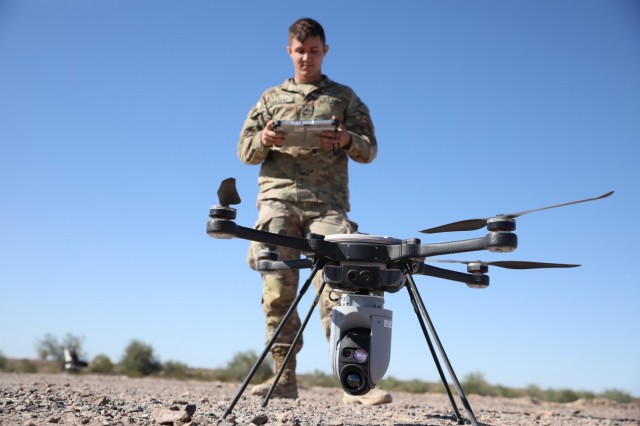Aprovechando la experiencia técnica y operativa de los miembros de las Fuerzas Armadas, y los socios de la industria de tecnología y defensa que asistieron al evento, los líderes del Ejército pudieron evaluar las fortalezas de las tecnologías y evaluar cómo sincronizar de manera más efectiva las maniobras tácticas conjuntas. Los organizadores de PC21 ejecutaron siete casos de uso para probar la interoperabilidad de las tecnologías Army y Joint durante el evento. Los esfuerzos dieron como resultado una ampliación significativa de la red de comando y control, lo que permitió la expansión de los rangos operativos y una mayor visibilidad del campo de batalla.
YUMA PROVING GROUND, Ariz. — Senior members of the Army gathered at Yuma Proving Ground, Arizona, on Nov. 9 to discuss preliminary outcomes of Project Convergence 2021 (PC21), a large-scale modernization experiment that brought together roughly 1,500 participants from across the Joint Force to field-test future warfighting capabilities.
The Army-led event, which took place over six weeks in October and November and included components at Yuma Proving Ground and White Sands Missile Range, New Mexico, represents the largest Joint Force experiment conducted in 15 years.
By leveraging the technical and operational expertise of participating Service members and civilians from the Army, Navy, Marine Corps, Air Force and Space Force, as well as tech and defense industry partners in attendance, Army leaders were able to evaluate the strengths of new military technologies and assess how to most effectively synch Joint tactical maneuvers.
“A lot of this is actually looking at how we use data, how we use software, how we use algorithms to better connect sensors to shooters,” said the Honorable Christine E. Wormuth, Secretary of the Army. Wormuth highlighted that continuing to hone Joint network and assured positioning, navigation and timing/space capabilities will be essential in furthering Joint All-Domain Command and Control.
In simulating the speed and scale of a multi-domain fight, PC21 illustrated the urgency of the U.S. military’s shared focus on attaining the speed, range and convergence required for competitive overmatch. Strategic exercises conducted as part of the experiment enabled the Joint Force to pinpoint which integrated networks and maneuvers worked well and which could benefit from additional improvements.
PC21 organizers executed seven use cases to test the interoperability of Army and Joint technologies during the event. The efforts resulted in a significant broadening of the command and control network, allowing for the expansion of operating ranges and greater battlefield visibility.
Also taking center stage at PC21 were a number of groundbreaking prototypes that incorporated artificial intelligence, robotics and autonomy to increase precision and lethality while mitigating risks to combat troops. The innovative systems and tools — some still in early development and others at or near completion — will offer the Army additional operational options and flexibilities.
“This is about technology, but this is also about how we fight and how we restructure the Army for the future,” explained Gen. John M. Murray, commanding general of Army Futures Command.
Many of the capabilities under development represent a shift away from focusing on counterinsurgency and counterterrorism and toward preparing for the possibility of large-scale conflict.
“We’re at an inflection point,” said Gen. James C. McConville, Chief of Staff of the Army. “In order to deter strategic competitors, we need to be able to do large-scale combat operations.”
Such operations typically involve the use of long-range precision fires and land warfare, which is why the Army is prioritizing the development of hypersonic missiles, next-generation combat vehicles and other battle-essential materiel.
“We’re looking for edge, we’re looking for advantage and we’re doing it working together as a Joint Force,” McConville said, adding that the Army is also “going to do it working together as a combined force with allies and partners” in the very near future.
Army leaders emphasized that the ability to test out new capabilities “in the dirt” as a combined force provides helpful insights into the future operational environment.
“One of the things we’ve learned over multiple exercises and regular iteration is the value of interacting and understanding where there’s friction points, where there’s literal or figurative firewalls and how to break those down,” said Brig. Gen. James P. Isenhower III, commander of the 1st Multi-Domain Task Force. “When we do, we find we can move faster, we can transmit data faster, we can make decisions faster.”
Maj. Gen. Christopher T. Donahue, commander of the 82nd Airborne Division, asserted that “the integrated tactical network is very robust, and it is living up to what we thought it would be.”
While the consensus was that the experiment produced promising results, Army leaders also acknowledged that budget constraints could influence the speed at which new technologies are rolled out across the military.
Despite these obstacles, leaders stressed that the Army’s modernization efforts are ongoing and extend beyond capstone events such as PC21. Karen Saunders, senior official performing the duties of the Assistant Secretary of the Army for Acquisition, Logistics and Technology, underscored the value of Soldier touchpoints in informing new and continuing acquisitions; “We’re refining the requirements all year long,” she said.
“We’re getting quality systems into the hands of Soldiers at the speed of relevance,” added McConville.
Army leaders also detailed mission-critical plans to incorporate new capabilities into enduring systems and programs of record; more closely align acquisition processes across the Services; modernize legacy logistics procedures; and reinvigorate and refine talent management procedures.
As Army and Joint Force officials continue to analyze data and consolidate observations and lessons learned from PC21, they are also commencing planning for Project Convergence 2022, which will further hone modernization advancements and include the participation of allied partners.
“The United States Army will never fight by itself,” Murray stated, explaining that the integration of Joint and allied force efforts will result in a stronger, faster, more lethal combined force capable of delivering unrivaled deterrence and overmatch.
Fuente: https://www.army.mil


